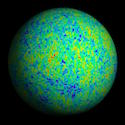|
|
1. planck data
- Three methods :
- N-R = Newton Rwphson Likelihood using the full covariance {$ 3 \times 2 \times npix $} matrix (CMB + noise)
- xLR : cross linear regression using the full covariance {$ 2 \times npix $} matrix (CMB + noise)
- oLR : ordinary linear regression, map pre-smoothed by a 3° fwhm beam.
- Maps pre-downgrading :
- loaded at nside 2048
- smoothed by a cosine beam
- {$ b_\ell = 1 \quad \ell \leq \ell_1$},
- {$ b_\ell = 0.5(1 + \cos((\ell-\ell_1) \pi/(\ell_2 - \ell_1))] \quad \ell_1 < \ell \leq \ell_2$},
- {$ b_\ell = 0 \quad \ell_2 < \ell$}
- downgraded at nside 16
- There is two types of dataset-split : half mission, and odd/even rings
- For each dataset split, there is 8 possible combinations to estimate the coefficient.
- P1 or P2 are the map to clean
- D1 or D2 are the 353GHz dust template
- S1 or S2 are the 30GHz synchrotron template
- We consider four masks : from fsky=0.9 to fsky=0.5
- Two types of error-bar :
- smaller ones computed from simulation with noise generated from planck cov maps
- bigger ones computed from simulation with public planck noise including sistematics.
1.1 alpha VS freq ; full by full
- error-bars (not shown) are as large as the dots
1.2 cleaning full by full, no noise weighting, then noise weighting
| white noise simus |  |  |  |  |  |
| planck ffp10 noise simus |  |  |  |  |  |
| planck data |  |  |  |  |  |
1.3 cleaning full by full. No noise weighting
| simus (FFP10, white noise) |  |  |  |  |  |
1.4 cleaning split by split (hm111)
| simus (FFP10, white noise) |  |  |  |  |  |
| planck hm data |  |  |  |  |  |
| planck oe data |  |  |  |  |  |
1.5 cleaning full by split
2. Old results (no more actual !) :
2.1 Full
2 coeff
1 coeff
2.2 oe / hm
MLE
2 coeffs
1 coeff
xnLR
s3oLR
3. old
3.1 Hm and oe
| Methods | 70 hm | 70 oe | 100 hm | 100 oe | 143 hm | 143 oe | 217 hm | 217 oe |
| N-R |  |  |  |  |  |  |  |  |
| xnLR |  |  |  |  |  |  |  |  |
| sLR |  |  |  |  |  |  |  |  |
3.2 full
4. simulations generated from planck cov maps
- 143 seesm biased on simulations. Do not known why. (pySM models ? )
- N-R performs best !
- grey bands indicate 1, 2, and 3 sigma dispersion of the input coeffidients maps (from pySM) {$ \alpha(\hat n) $}
4.1 Hm and oe
4.2 full
5. public planck simulations
5.1 Hm and oe
5.2 full
|
|

























































































































































